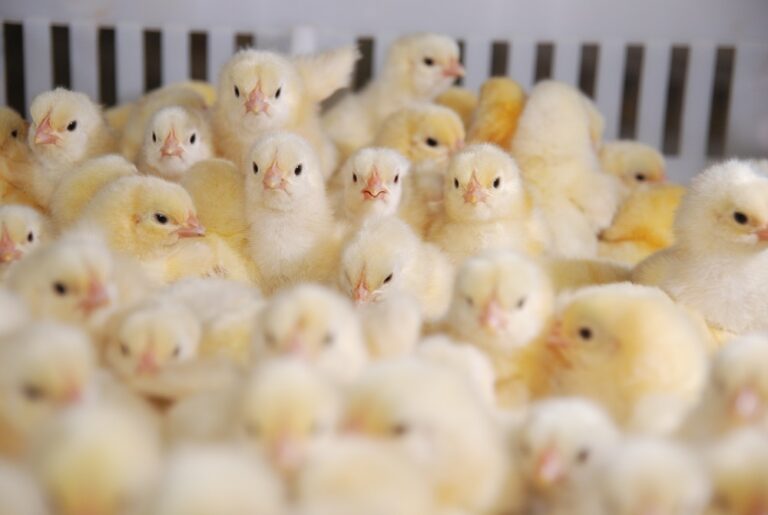A new report recommends government should make chick culling illegal. How soon might it happen?
France and Germany have in recent years banned the culling of newly hatched male chicks, driven by consumer and NGO pressure.
Now a new report in the UK from the Animal Welfare Committee, an expert panel that advises Defra, the Scottish Government and the Welsh government, has recommended the UK should follow suit. It recommends the practice should be made illegal, as soon as reliable, accurate methods for sexing eggs prior to hatch are available in British hatcheries.
An estimated 40 to 45 million newly hatched male chicks hatched into the laying sector are culled in Britain each year. Most are culled with argon gas, within hours of hatching. Smaller numbers are culled in the broiler breeder sector, as well as some newly hatched turkey poults and newly hatched ducklings.
No timescale has been put on this aim, and the Government has plenty else to occupy it at the moment. So, the likelihood of anything changing soon is remote. In fact, Mark Spencer, the farming minister, was not even aware of the existence of the report until weeks after it was published, a well-placed source told PB.
Prepare for change
However, as the poultry industry is well aware, change can happen rapidly if NGO and consumer pressure suddenly increases, and therefore, the industry must be prepared.
So, what does the picture look like in countries where culling has been phased out?
France and Germany jointly banned chick culling at the start of 2022. Italy is planning to do the same in 2026. While there are many derogations to the rules, particularly in France, there have been some significant changes.
The expectation now is that all male chicks must be reared to a normal broiler slaughter age. Rearing may occur within the country of hatching or in other EU or third countries, including Africa and Russia.
Because there is no market in Europe for the meat from layer breeds, this means that in practice, nearly all of the males are exported. This has had some unintended consequences. In Africa in particular, the import of these birds has had significant negative impacts on poultry businesses, by flooding the market with cheap product, undermining local businesses, which are often run by women on a small scale to support their families.
Technological solution
Because exporting males is a costly and inefficient outcome, efforts are ramping up to avoid hatching males in the first place.
For almost a decade, there has been the promise of a technological answer, and the report examines all the current options, including processes that can identify the sex of the chick before hatching.
As the report explains, in countries in which in-ovo sexing technologies for chicks are in use, a typical business model is that a technology owner places the sexing machinery in a hatchery and operates it on a contract basis. The hatchery pays the technology owner a fee for each egg analysed or for each female hatched. This results in an additional cost for each layer chick supplied, which is then passed on to the pullet farmer or rearer.
There are significant costs associated with this system. A female chick that has been sexed in-ovo might cost a farmer £3, the report points out, which is four times the 75p price for a standard chick. “Spread across approximately 350 table eggs, laid over a bird’s lifespan, this equates to a little under a penny extra per table egg,” the report states.
The licensing model of using machinery removes the requirement for a high level of capital investment, which is around £2 million for an in-ovo sexing machine.
Genetic modification
There has also been some limited research discussion of using genetic modification to determine egg sex. “For example, the CRISPR (Clustered Regularly Interspaced Short-Palindromic Repeats) and Cas9 (CRISPR-associated-protein 9) gene editing system could potentially be used to trigger lethality in male embryos, with the modified DNA being activated when eggs are exposed to blue light for several hours,” the report states. This method is still way off from becoming a commercial reality, however.
Ethics versus welfare
The ethics of the whole topic is examined in the report. Chick culling is “ethically problematic”, the committee argues, and is part of what it calls a ‘legacy system’ which if it did not already exist, would not be considered acceptable to be newly introduced.
While the committee acknowledges that if done correctly using humane methods, the culling of chicks is not a welfare issue, it makes the case that it is desirable to reduce the number of chicks culled to the minimum number possible “given the current state of technology.”
The view of the committee echoes sentiments expressed in other European countries where consumer research has found culling to be ‘unpalatable’. The report states: “It has been reported to AWC that some hatchery staff dislike killing newly hatched chicks because it goes against the goal of producing healthy chicks.”
However, there are ethical considerations associated with not culling chicks. There is a real concern about what would happen if this valuable source of protein were to suddenly become unavailable.
As the report explains, culled chicks are in high demand. They are mainly sold to zoos and specialist exotic pet companies that supply feed for reptiles and birds of prey. The UK is only 70% self-sufficient in this niche market, meaning UK businesses already import culled chicks to serve this market.
One area of real concern is that if this product suddenly became unavailable, the market could quickly be filled with suppliers of newborn rodents. Unregulated rat and mice farms could be set up – in some cases literally in people’s garages – with horrible consequences for the welfare of those rodents.
Uncertain way forwards
What the report does well is explain this is not a straightforward subject. What is clear though is that when one country moves to legislate, others tend to follow suit sooner or later. While an imminent change in the law in the UK is unlikely, it is only a matter of time before technology makes routine chick culling a thing of the past.
Q&A with Gary Ford, chief executive, British Egg Industry Council

Does the BEIC support the key recommendation of the report, that routine culling should become illegal once technological solutions become more widely commercially available?
The BEIC has long maintained that a legal ban is not required as the UK commercial layer hatcheries will embrace in-ovo sexing technology when it is proven to be commercially viable i.e. accurate and without adding significant cost. The best solution is for sexing of an embryo to take place before the fertile egg is placed in the setter. Work on such technology is ongoing but is not yet available. Once available, this would be embraced by hatcheries the world over. Current in-ovo technologies require more eggs to produce the same number of female chicks, which is not efficient and leads to waste. In addition, the age at which embryos can be sexed has to be reduced from the current figure of around 13 days of incubation, as an embryo can feel pain.
What kind of challenges does this pose, particularly around costs or practicalities of phasing out routine culling?
Using current technology, more eggs will be required to be set to produce the same number of female chicks due to sexing inaccuracies. In addition, the throughput of the hatchery is significantly reduced as a result of the time taken to sex the embryo. This will increase the cost of producing a day-old chick which will be reflected in the pullet price and ultimately the cost of eggs – all at a time of a cost of living crisis.
In addition, rearing male chicks for poultry meat production is not commercially viable. Where this is happening in Europe, it is understood that the meat from these birds is being exported to West Africa which is disrupting the local market.
In the UK, male day old chicks, once euthanised using argon gas, are a valuable food source for zoos, birds of prey centres, and reptiles. If UK hatcheries could no longer supply these sectors, an alternative would have to be found, including imports. This could potentially come from a range of sources, which would be unregulated and lead to different ethical concerns.
The report states that the Government should support the development and use of dual-purpose breeds, such as via regenerative and agroecological farming programmes, especially in line with the Climate Change Committee’s recommendation on a reduction in meat consumption to achieve the government’s net zero emissions target. This we believe would be wholly the wrong thing to do as it would impact negatively on Carbon footprint due to inefficiencies.
What is the BEIC’s response to the committee’s conclusion that routine culling is ethically problematic?
It is seen by some as an ethical issue however, it could be argued that culling a 13 day embryo is also ethically problematic.
On what kind of timescale would any shift away from routine culling be possible?
Difficult to say but only when the technology is able to deliver accuracy at ‘day zero’, i.e. before the start of incubation. Currently this technology is not commercially available.


